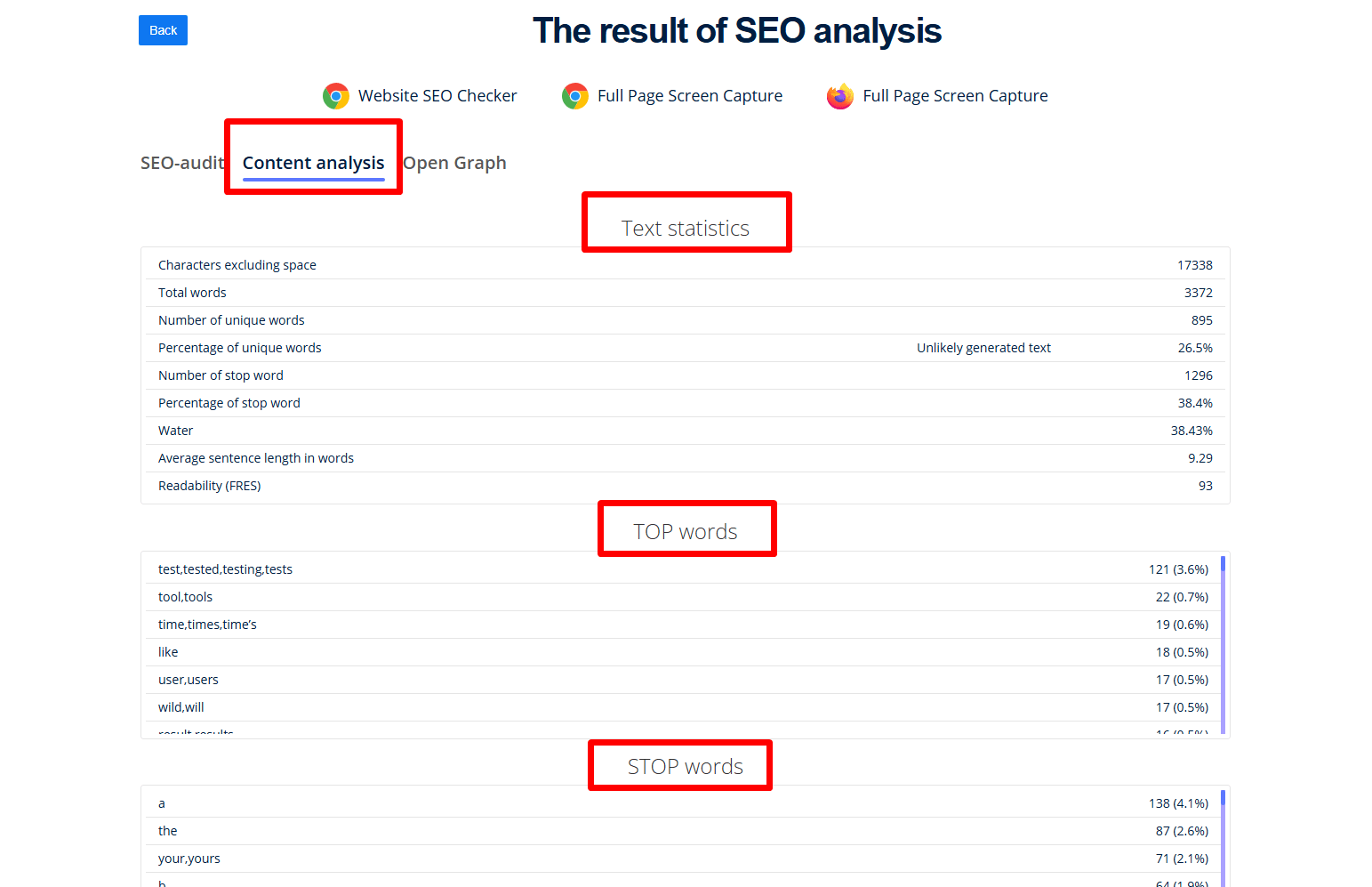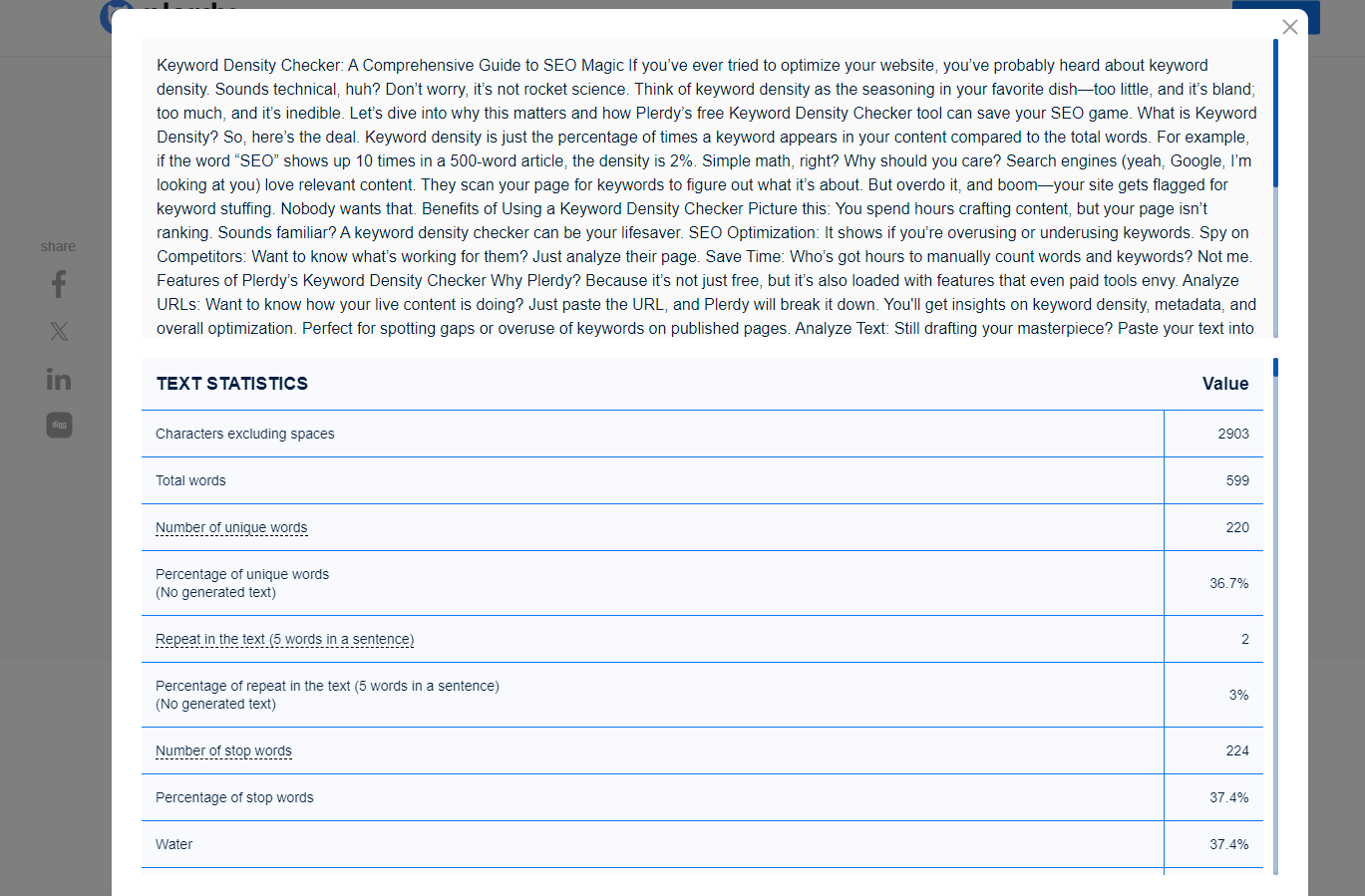









-
4.9/5
-
4.7/5
-
-
You have most likely heard about keyword density if you have ever worked to maximize your website. Sounds technical, now? hardly to worry; this is hardly rocket science. Consider keyword density as the spice in your preferred meal: too little, it is insipid; too much, it is inedible. Let's explore the reasons this is important and how Plerdy's free Keyword Density Checker tool might save your SEO performance.
Using Plerdy's Keyword Density Tool: Guidelines
It's rather easy. Not need a PhD.
- Paste your URL or text into the utility.
- Hit "Check."
- Get a report including all the tantalizing specifics—keyword frequency, density, and much more.

Result for URL Check

Result for Text Check

Edit your material now till it's absolutely right. Simple yet right?
Features of Plerdy's Keyword Density Checker
Plerdy: Why? Not only free, but is also loaded with capabilities that even premium tools envy for.
- Analyze URLs: Would like to know how your live material is performing? Plerdy will break down only pasting the URL. You will gain understanding of general SEO, metadata, and keyword density. Ideal for pointing up holes or misuse of keywords on recently released pages.
- Review Text: Still under progress on your masterpiece? Paste your text into the tool to observe the stack-ability. You will know exactly what has to be changed from keyword density to readability before publishing.
- Detailed Insights: Get the dirt on total words, unique words, stop words, readability score, even the percentage of water words.
- Meta data analysis: Review your meta titles, H1 tags, alt texts, internal and outside links.
- First for privacy: Plerdy stores none of your info. Trust me; these days, that is quite unusual.
Why Keyword Density Still Matters In 2025
Search teams still argue about keyword density, but users vote with scroll and clicks. If a page repeats one keyword 40 times, you feel tired. If it never mentions the term, you doubt relevance. Simple truth: you must check balance. Google’s systems care about intent, semantics, and helpfulness, yet terms still anchor meaning. I’ve seen product pages add one missing keyword variant and revenue jump 7–12% in two weeks. Not magic, just alignment. A tool won’t write your story; it shows blind spots. Use the signal, then edit with taste. If you want a quick pulse check, a keyword density analyzer highlights overused nouns in seconds. You want clear promise, natural nouns, strong verbs, short sentences. Keep it human. Keep it honest. Before you publish, always check keyword density against your top three competitors.
When Density Hurts UX
Overdoing keyword density breaks rhythm, makes you sound robotic, and pushes bounce. You can check this in five minutes: read the page out loud. If your tongue trips, the tool warning is already in your mouth. Thin synonyms help: “pricing,” “cost,” “budget,” not the same noun on repeat. Add supporting entities—brand, model, use case, location—so your keyword sits in a real story, not a spam cloud. When copy feels heavy, run a keyword stuffing checker and trim repeats. A simple word density checker can flag awkward clusters your eye skips.
When Density Helps Search Intent
Low density is also a problem. If the keyword is missing on hero, H2, and one CTA, relevance drops. Do a fast check: can a new visitor guess the offer in ten seconds? If not, lift the main term once in headline, once in intro, once in a CTA. Let the tool confirm coverage, then stop. You’re training scanners and bots at the same time. For distributed teams, a keyword density checker online keeps reviews consistent.
Benchmarks, Not Myths
There is no magic keyword density number. Treat it as a benchmark to check clarity, not a law. For reference, I see high-performing pages with 0.8–2.2% for the head term, plus 8–15 semantically connected phrases. That’s a direction, not a rule. Use a tool to collect the range from winners in your niche, then adapt to your tone and intent. Blog essays tolerate lower density and wider vocabulary. Category pages tolerate tighter phrasing because users scan fast. Landing pages live between those worlds. The best benchmark is the page that already sells. You can start with a free keyword density checker to gather a baseline range. For budget-conscious audits, a keyword density checker free still catches obvious issues.
Safe Ranges By Page Type
Rough guide for a check:
- Blog how-to: 0.6–1.2% main keyword density, 10–20 secondaries across H2/H3.
- Category: 1.0–2.0%, plus brand/model entities.
- Landing: 0.8–1.6% and strong CTA anchors.
Track keywords density by block to see where intent weakens. If needed, spin up a keyword density analyzer online free for a fast reality check. Use your tool to watch variants: plural, geo, product code, season. Numbers matter, but readability wins.
When To Break The Rules
If intent is ultra-specific (e.g., “Nike Pegasus Trail 5 men”), higher density can fit. That’s fine when the keyword is product truth, not fluff. Do a sanity check with competitors in Semrush, Ahrefs, or Surfer. If top results repeat a rare spec term (chipset, SKU, wattage), mirror the pattern. Your tool shows thresholds; your judgement sets the ceiling. Even a basic key word density checker helps junior editors avoid stuffing. For niche SERPs, shortlist the best keyword density checker before you standardize.
Competitive Reality Check
SEO isn’t a vacuum. Don’t just repeat density keywords; weave them into benefits and proof. An advanced keywords density checker tool visualizes term clusters across headings and CTAs. Competitors train your market. Pull the top five URLs and check their keyword density, headings, and money phrases. If everyone says “free shipping” and you whisper it once in a footer, you’re leaving cash on the table. I measured a Shopify store where adding two missing keywords (“next-day delivery”, “30-day returns”) lifted CVR by 9.4% and lowered CPA by $0.83. A tool helps you see the gaps; content design closes them.
Quick Gap Method
Run a simple check with any tool and map:
- Primary keyword in H1/H2?
- Synonyms in bullets?
- Offer nouns near CTAs?
For ongoing QA, a keyword density tool checker gives a quick green-red signal on each draft. Then add one unique proof: stat, guarantee, or name (e.g., “as Rand Fishkin noted in 2024 surveys”). Close with a short sentence that sells, not shouts.
Content Quality, E-E-A-T, And Conversion
You can hit perfect keyword density and still feel empty. Pair a keyword density tool seo with behavior analytics to see if clarity actually improves clicks. Watch seo keywords density after updates, especially when templates or CTAs change. E-E-A-T is your spine: experience, expertise, authority, trust. Show a human voice, show who wrote it, show outcomes. Add quotes from known folks (Barry Schwartz, Aleyda Solis), add prices, add timeframes. Readers trust receipts. Do a fast check: can a stranger verify one claim without effort? If yes, your tool report becomes context, not a crutch. Great pages win two battles—ranking and convincing.
Signals You Can Control
Add real-world elements around the keyword set: case study months, refund windows, SKU numbers, data ranges. Power users will appreciate a keyword density analyzer tool that exports page-level and section-level reports. Put contact info where eyes expect it. Place the tool insights into short paragraphs, not one giant block. Final check: would you send this to your boss with your name on it? Then ship.
Workflow That Scales Without Burnout
Teams drown in drafts. For small teams, a keyword density tool free is enough to keep phrasing honest. Larger content groups often standardize on keyword density checker tools to keep tone consistent across writers. Keep a short loop: research, outline, write, check density, read out loud, ship, measure. Use cool tool stacks, but keep your craft. Example stack that doesn’t fight your brain: Google Docs for writing, Plerdy for behavior data, Semrush or Ahrefs for keyword sets, GA4 for revenue. Aim for steady density, clean headings, and one brave angle per page. Boring wins. Money follows.
Mini Checklist For Editors
- One main keyword on hero; density not crazy.
- Two to four secondary terms; check CTAs for clarity.
- One proof (percent, dollar, quote, or date).
- Tool screenshot optional, but story first.
- Read out loud before publish.
For deeper audits, a keyword density analysis tool lets you compare winners side by side. A reliable keywords density checker also highlights over- or under-used synonyms near CTAs.
Conclusion
Use keyword density as a compass, not a cage. Do a fast check, adjust copy, and let your tool confirm balance. Write for people, prove with data, compete with taste. That mix outperforms myths.
What’s A Healthy Keyword Density Range?
For most pages, 0.8–1.6% for the main keyword is a practical range. Treat it as a check, not a law. A tool helps you stay in bounds, but readability wins every time and user intent comes first.
FAQ — Keyword Density Checker
Can I Rank With Low Keyword Density?
Yes, if intent is clear and supporting entities add context. Still, mention the term in key places. Do a quick check in H1/H2 and CTAs; let a tool verify coverage so relevance is obvious to scanners and bots.
Do I Risk Penalties For High Density Or Stuffing?
The biggest risk is poor UX. If copy feels spammy, users bounce and engagement signals drop. Run a check, trim repeats, and vary nouns and entities. A smart tool can flag stuffing patterns before you publish.
Should I Copy Competitor Density Numbers Exactly?
Use competitor ranges as a starting point, not a template. Compare, check gaps, then write your own story. A tool shows ranges; your offer, proof, and tone convert visitors into customers.
Does Density Matter For Brand Pages Or PR Posts?
Pressure is lower there. Keep the keyword present for context, but focus on narrative and trust signals. Do one quick check to avoid zero mentions, then support with quotes, data, names, and dates.






































